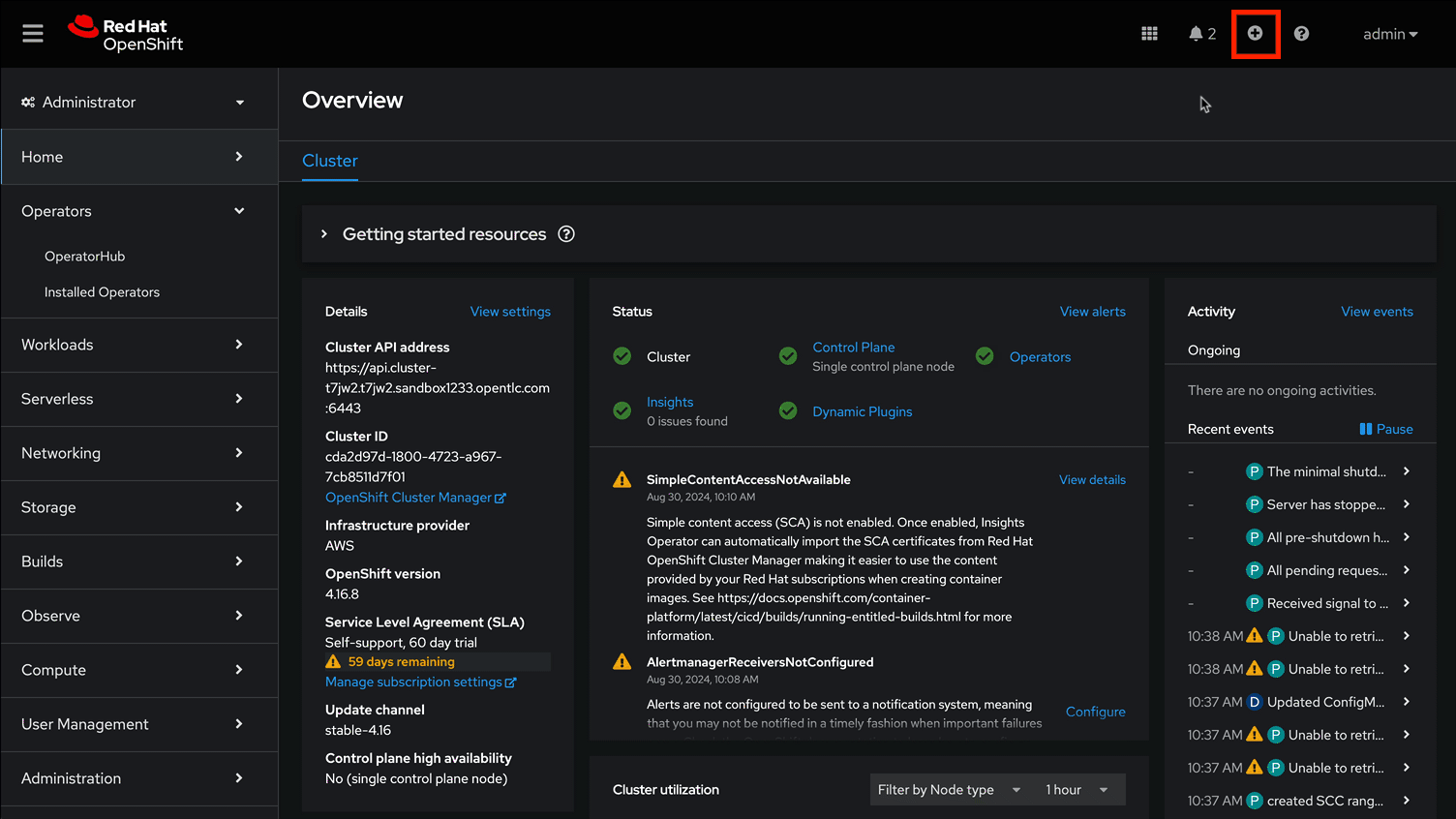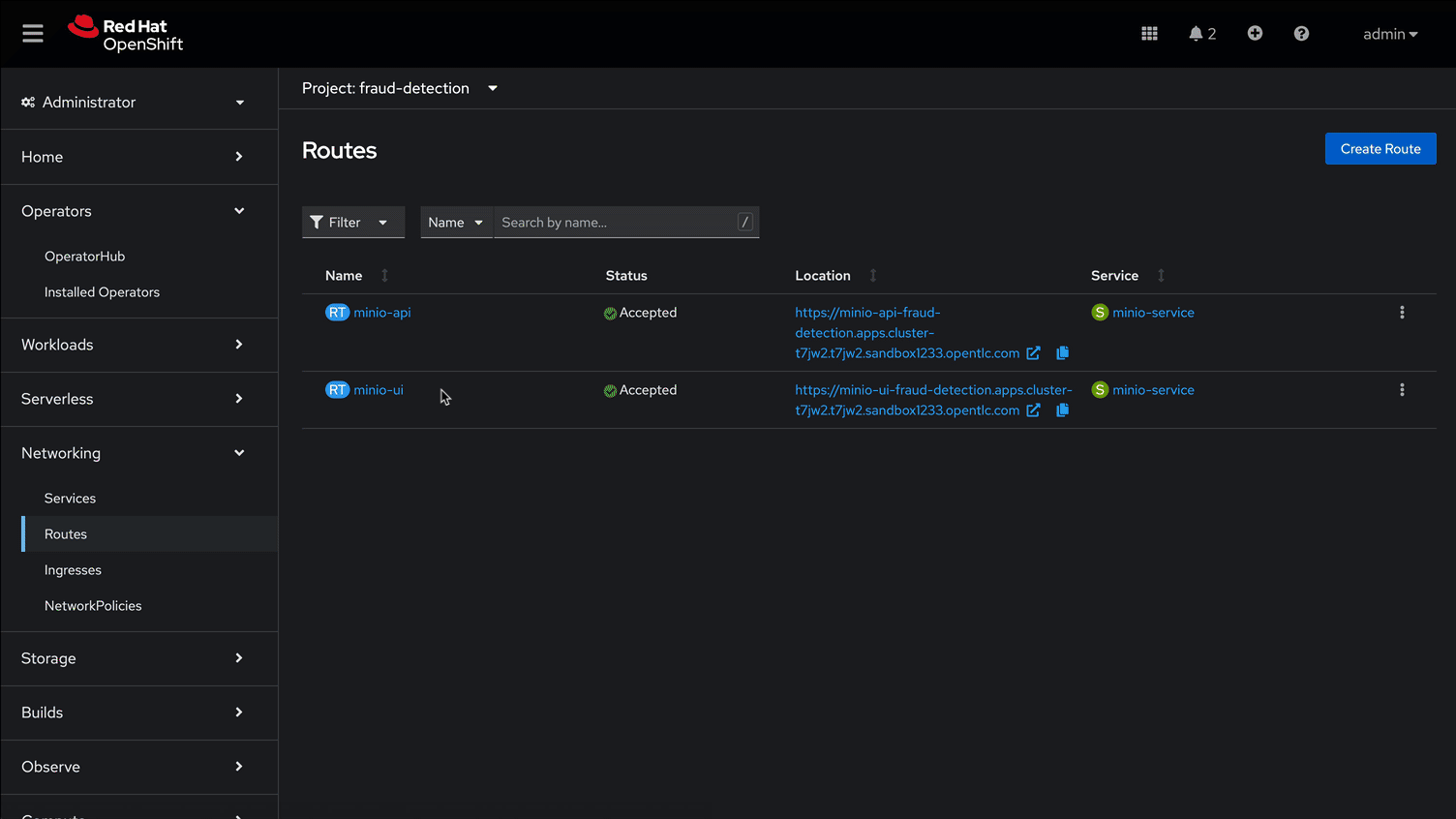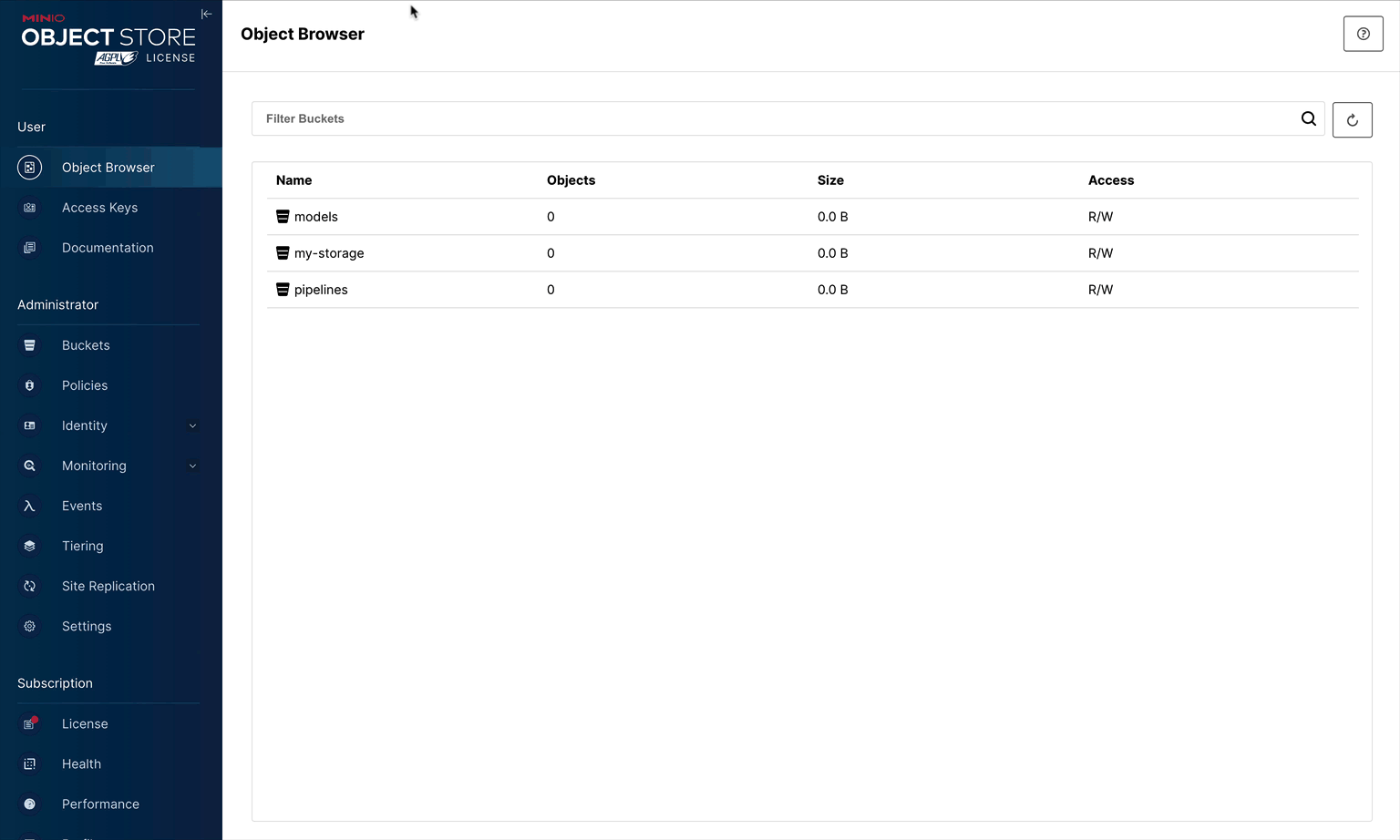MinIO S3 Compatible Storage Setup
Deploy MinIO as S3 compatible storage
MinIO overview
MinIO is a high-performance, S3-compatible object store. It can be deployed on a wide variety of platforms, and it comes in multiple flavors.
This segment describes a very quick way of deploying the community version of MinIO in order to quickly setup a fully standalone Object Store, in an OpenShift Cluster. This can then be used for various prototyping tasks that require Object Storage.
| This version of MinIO should not be used in production-grade environments. Additionally, MinIO is not included in RHOAI, and Red Hat does not provide support for MinIO. |
MinIO Deployment
To Deploy MinIO, we will utilize the OpenShift Dashboard.

-
Then Select the + (plus) icon from the top right of the dashboard.
-
In the new window, we will paste the following YAML file. In the YAML below its recommended to change the default user name & password.
-
Click on the Project Selection list dropdown and select the ollama-model project or the data science project you created in the previous step.
-
Select the create button to deploy the Minio software.
Minio Deployment Code
Click to view and copy Minio deployment code.
kind: PersistentVolumeClaim
apiVersion: v1
metadata:
name: minio-pvc
spec:
accessModes:
- ReadWriteOnce
resources:
requests:
storage: 40Gi
volumeMode: Filesystem
---
kind: Secret
apiVersion: v1
metadata:
name: minio-secret
stringData:
# change the username and password to your own values.
# ensure that the user is at least 3 characters long and the password at least 8
minio_root_user: minio
minio_root_password: minio321!
---
kind: Deployment
apiVersion: apps/v1
metadata:
name: minio
spec:
replicas: 1
selector:
matchLabels:
app: minio
template:
metadata:
creationTimestamp: null
labels:
app: minio
spec:
volumes:
- name: data
persistentVolumeClaim:
claimName: minio-pvc
containers:
- resources:
limits:
cpu: 250m
memory: 1Gi
requests:
cpu: 20m
memory: 100Mi
readinessProbe:
tcpSocket:
port: 9000
initialDelaySeconds: 5
timeoutSeconds: 1
periodSeconds: 5
successThreshold: 1
failureThreshold: 3
terminationMessagePath: /dev/termination-log
name: minio
livenessProbe:
tcpSocket:
port: 9000
initialDelaySeconds: 30
timeoutSeconds: 1
periodSeconds: 5
successThreshold: 1
failureThreshold: 3
env:
- name: MINIO_ROOT_USER
valueFrom:
secretKeyRef:
name: minio-secret
key: minio_root_user
- name: MINIO_ROOT_PASSWORD
valueFrom:
secretKeyRef:
name: minio-secret
key: minio_root_password
ports:
- containerPort: 9000
protocol: TCP
- containerPort: 9090
protocol: TCP
imagePullPolicy: IfNotPresent
volumeMounts:
- name: data
mountPath: /data
subPath: minio
terminationMessagePolicy: File
image: >-
quay.io/minio/minio:RELEASE.2023-06-19T19-52-50Z
args:
- server
- /data
- --console-address
- :9090
restartPolicy: Always
terminationGracePeriodSeconds: 30
dnsPolicy: ClusterFirst
securityContext: {}
schedulerName: default-scheduler
strategy:
type: Recreate
revisionHistoryLimit: 10
progressDeadlineSeconds: 600
---
kind: Service
apiVersion: v1
metadata:
name: minio-service
spec:
ipFamilies:
- IPv4
ports:
- name: api
protocol: TCP
port: 9000
targetPort: 9000
- name: ui
protocol: TCP
port: 9090
targetPort: 9090
internalTrafficPolicy: Cluster
type: ClusterIP
ipFamilyPolicy: SingleStack
sessionAffinity: None
selector:
app: minio
---
kind: Route
apiVersion: route.openshift.io/v1
metadata:
name: minio-api
spec:
to:
kind: Service
name: minio-service
weight: 100
port:
targetPort: api
wildcardPolicy: None
tls:
termination: edge
insecureEdgeTerminationPolicy: Redirect
---
kind: Route
apiVersion: route.openshift.io/v1
metadata:
name: minio-ui
spec:
to:
kind: Service
name: minio-service
weight: 100
port:
targetPort: ui
wildcardPolicy: None
tls:
termination: edge
insecureEdgeTerminationPolicy: RedirectThis should finish in a few seconds. Now it’s time to deploy our storage buckets.
MinIO Storage Bucket Creation
From the OCP Dashboard:

-
Select Networking / Routes from the navigation menu.
-
This will display two routes, one for the UI & another for the API. (if the routes are not visible, make sure you have the project selected that matches your data sicence project created earlier)
-
For the first step, select the UI route and paste it or open in a new browser tab or window.
-
If you see a landing page with the message application not available, refresh the page a few times as the service is still loading.
-
The displayed page is the MinIO Dashboard. Log in with the username/password combination you set, or the defaults listed below.
-
username = minio
-
password = minio321!
-
Once logged into the MinIO Console:
-
Click Create Bucket to get started.
-
Create two Buckets:
-
models
-
storage (optional)
-
| When serving an LLM or other model, Openshift AI expects to search within a directory. Therefore, we need at least one subdirectory under the models folder. |
-
Via the Navigation menu, select object browser, then click on the Model Bucket.
-
From the models bucket page, click add path, and type ollama as the name of the sub-folder or path.
| In most cases, to serve a model, the trained model would be uploaded into this sub-directory. However, Ollama is a special case, as it can download and manage Several LLM models as part of the runtime. |
-
We still need a file available in this folder for the model deployment workflow to succeed.
-
So we will copy an emptyfile.txt file to the ollama subdirectory.
You can download the file from this location(use right click, save link as). Alternatively, you can create your own file called emptyfile.txt and upload it.
-
Once you have this file ready, upload it into the Ollama path in the model bucket by clicking the upload button and selecting the file from your local desktop.

With our S3 Compatible ready to go and our "model files" uploaded. Let’s head back to the OpenShift AI Web UI and continue configuring resources.